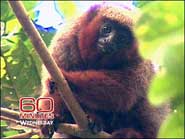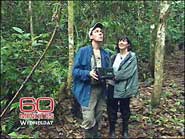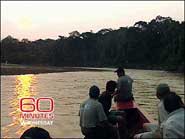 |
 |
|
» Back to Main Page » The Auction » The Winning Bid » All About Madidi » The Scientist and the Monkey » 60 Minutes Seeks The Monkey » WCS Protects Madidi Land And Species » The GoldenPalace.com Monkey » How the Monkey was Discovered » Scientists Observe Monkeys » Focus on Madidi's Diverse Wildlife  |
60 Minutes Searches For The New Monkey The CBS award winning news program 60 minutes ventured into the Bolivian Jungle in South America in search of the newly discovered species of monkey.
The CBS award winning news program 60 minutes ventured into the Bolivian Jungle in South America in search of the newly discovered species of monkey.
The jungle of the national park of Madidi in the Amazon is home to a species of monkey that has never been seen before. 60 Minutes correspondent Christiane Amanpour reported on this remarkable discovery. "Imagine a place which starts with that kind of landscape and goes all the way down to lush tropical forests," says British biologist Rob Wallace. "Finding a new species is always a big deal. Finding a new species of mammal, which many people find more inspirational, is a big deal. And finding a new species of monkey is a huge deal." For the last ten years, Wallace has been working in the Bolivian wilderness for the Wildlife Conservation Society of New York. His discovery is something that most scientists will never experience in an entire lifetime of work.  Wallace led 60 Minutes on an adventure to find the new monkeys. Their journey was more than they hoped for. At one point the group encountered a giant Andean condor with a wingspan of 10 feet - the largest flying creature in the world.
Wallace led 60 Minutes on an adventure to find the new monkeys. Their journey was more than they hoped for. At one point the group encountered a giant Andean condor with a wingspan of 10 feet - the largest flying creature in the world.
The mostly unexplored national park of Madidi is over a 100 miles of untouched wilderness. While only about the size of New Jersey, Madidi is incredibly rich with all kinds of exotic animal life and is one of the most extraordinary places on earth. Madidi is home to the likes of South American crocodiles and Capibara - the largest rodents on earth. The park is so incredibly diverse that it is estimated to contain approximately 1100 species of birds - more than the entire continent of North America. Wallace and the 60 Minutes team managed to locate the new species by playing a recording of the sounds of the new monkeys and the monkeys answered back. The group saw an orange ball of fur and for the first time caught site of the new monkey species. "They are beautiful monkeys. They’re a bit like a teddy bear," says Wallace. "The main characteristic is this golden crown color."  The bright color of the monkey was Wallace’s first hint that he had discovered a new species of monkey - a discovery now supported by the scientific community. All the monkey needs now is a name.
The bright color of the monkey was Wallace’s first hint that he had discovered a new species of monkey - a discovery now supported by the scientific community. All the monkey needs now is a name.
Asked if he would name the monkey after himself, Wallace replied that that’s not normally done. They could give the monkey its Latin name but the decision has been made to auction off the right to name the monkey in a effort to help raise funds for the Madidi national park. The auctioning of scientific immortality is expected to generate some high bids. |
 |
|
| Copyright © 2026 GoldenPalaceMonkey.com. All rights reserved. This site is in no way affiliated with WCS.org. |
|
